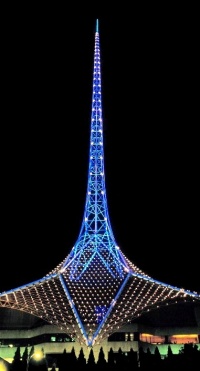Beacon (Cairony)
A beacon is a tower attached to a Cairan temple, usually its most pre-eminent architectural element. First appearing as a feature in the late classical era and under the Secotic occupation, the beacon had the primary function of hosting a fire that would ward off evil spirits during the night, protecting the community's cairon, thus symbolising the permanence of society against disorder and Aedif's benevolent watch over mankind (a practice similar to, but distinct from, the eternal flames kept by the Sacred Flame Order). It also served the welcome function of guiding travellers to the community (in some coastal cities beacons served as the city's lighthouse). The common Cairan symbol of the Vigil's Star derives from this original function.


The purpose of beacons later expanded. Bells and other percussion instruments like carillons were installed in beacon towers to help with communal timekeeping and for warning and announcements, as well as for certain specific ritualistic activities. In time mechanical clocks were often added to the beacons. In a number of locations (particularly those associated with Saint Viola) pipe organs were integrated in the structure of the beacon to assist with cantatas and to project sound outwards. Today, beacons continue to host a fire lit daily, though old-fashioned fireplaces have been replaced by more modern methods, usually some gas-fired flame.
Over time beacons became taller, especially during the heyday of Sagittairian architecture in the 14th and 15th centuries, when they became topped with flèches of extravagant heights; a celebrated example is Etamps-La-Sainte’s Sagittae Templum which reached a height of 142 metres. During the same period many temples saw the building of two symmetrical beacon towers ensconcing an ornamented façade that hid the rest of the temple's structure, or opened into a large extension hall. Neo-Sagittairian architecture led to a revival of construction of such flèches in the 20th century.
In some architectural traditions, in particular in the 17th and 18th centuries, the beacon tower has been replaced by a dome. In this case the fireplace is placed into a small belvedere on top of the dome.
Nomenclature
In Savamese and other Sabamic languages beacon towers are known under several different names. The first tradition uses the word balise, originally from Late Sabamic palitium, a stake or post. The Ellish term derives from this usage, which appears to be more common in western areas of the Sabamic world. In the east, the term luminaire (rendered in Ellish as luminary) is used more frequently; this is derived from Late Sabamic lūmināre/lūminārium, "that which gives light".